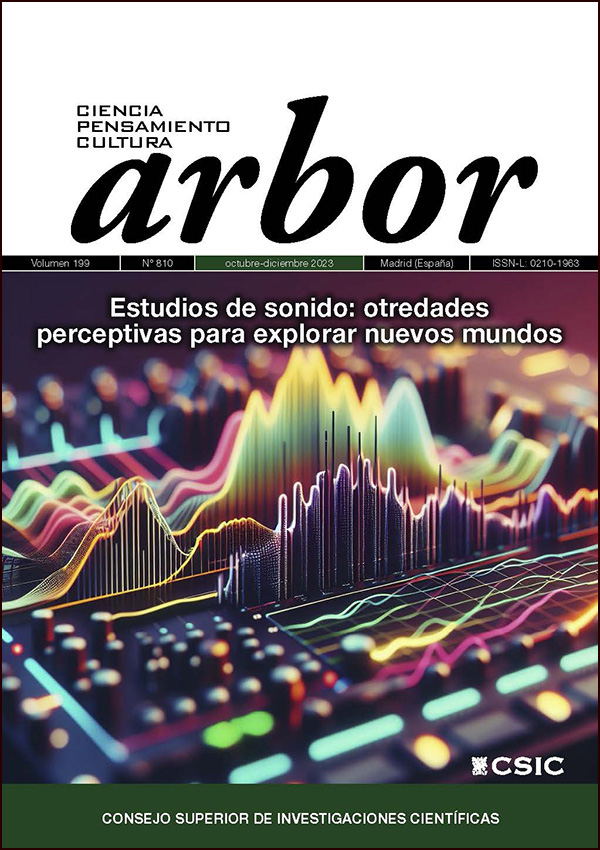AI meets ALP in voce
DOI:
https://doi.org/10.3989/arbor.2023.810010Keywords:
Sonic, transcription, AI, drawing, agrammaticalAbstract
Finnegans Wake is the last work written by Irish writer James Joyce. In it, the increasing narrative complexity that characterised his literature reaches extreme levels, verging on the unintelligible. The author not only mixes different languages, he also invents new terms that germinate and are signified, to a large extent, from their sonic dimension. Characters as well as real and fictitious events are mixed together, forming an amalgam in which a perpetual cyclical glocality of mythological archetypes is perpetuated. The female protagonist, Anna Livia Plurabelle, is a mutating character who becomes different natural elements throughout the text. The murmur of the river mingles with her own in a narrative pulse that overrides the shore. Voices are always heard in the background and, although they are not clear, are suggestive.
This literary work is not to be read, it is to be listened to; it is not to be understood, it is to be deduced.
This research is situated within the current context of the boom in the use of Artificial Intelligence (AI) on word processing. It puts the transcription of some spoken passages from Finnegans Wake to the test, evaluating the degree of accuracy and possible biases or deviations in the results. This work is part of the results of a research stay granted by the Moving Minds call from the Campus Mare Nostrum at the University of Murcia.
Downloads
References
Ananny, Mike y Karr, Jake (2023). Press freedom means controlling the language of AI. Disponible en: https://www.nie-manlab.org/2023/09/press-freedom-means-controlling-the-language-of-ai/
Bernárdez, Asunción (2023). Ecoficciones. Cine para sentipensar la crisis climática. Valencia: Tirant Humanidades.
Brittain, Blake (2023). Getty images lawsuit says Stability AI misused photos to train AI. Reuters. Disponible en: https://www.reuters.com/legal/getty-images-lawsuit-says-stability-ai-misused-photos-train-ai-2023-02-06/
Broussard, Meredith (2023). More than a Glitch: Confronting Race, Gender, and Ability Bias in Tech. Massachusetts: The Mit Press. https://doi.org/10.7551/mitpress/14234.001.0001
Coyle, Diane (2021). Cogs and Monsters: What Economics Is, and What It Should Be. Princeton and Oxford: Princeton University Press. https://doi.org/10.1515/9780691231037
De la Torre, Blanca (2022). Vientos de cambio: transición ecosocial y ecofeminismos. Atlántica. Revista de Arte y Pensamiento, 4, 5-8.
Derrida, Jacques (2006). L'animal que donc je suis. Paris : Galilée.
Lacivita, Alison (2015). The ecology of Finnegans wake. United States of America: University Press of Florida. https://doi.org/10.2307/j.ctvx073c3
Franzen, Carl (2023). The AI feedback loop: Researchers warn of 'model collapse' as AI trains on AI-generated content. VentureBeat. Disponible en: https://venturebeat.com/ai/the-ai-feedback-loop-researchers-warn-of-model-co-llapse-as-ai-trains-on-ai-generated-content/
Joyce, James [1939] (2012). Finnegans Wake. Hertfordshire: Wordsworth Editions.
Perales, Verónica (2022). Plurabelle, "foriver her allinall". Atlántica. Revista de Arte y Pensamiento, 4, 27-32.
Puleo, Alicia H. (2006). No debemos renunciar a la posibilidad de ir dejando huellas de nuestro paso. Lectora, 12, 107-112.
Puleo, Alicia H. (2011). Ecofeminismo para otro mundo posible. Madrid: Cátedra.
Rotman, David (2022). How to solve AI's inequality problem. MIT Technology Review. Disponible en: https://www.technologyreview.com/2022/04/19/1049378/ai-inequality-problem/
Shumailov, Ilia; Shumaylov, Zakhar; Zhao, Yiren; Gal, Yarin; Papernot, Nicolas; Anderson, Ross (2023). The Curse of Recursion: Training on Generated Data Makes Models Forget. ArXiv. /abs/2305.17493 https://doi.org/10.48550/arXiv.2305.17493
Simon, Félix M. (2022). The Elephant in the Room: How AI could give technology giants more control over the news. Oxford Internet Institute. Disponible en: https://www.oii.ox.ac.uk/news-events/news/the-elephant-in-the-room-how-ai-could-give-technology-giants-more-control-over-the-news/#main
Published
How to Cite
Issue
Section
License
Copyright (c) 2024 Consejo Superior de Investigaciones Científicas (CSIC)

This work is licensed under a Creative Commons Attribution 4.0 International License.
© CSIC. Manuscripts published in both the printed and online versions of this Journal are the property of Consejo Superior de Investigaciones Científicas, and quoting this source is a requirement for any partial or full reproduction.
All contents of this electronic edition, except where otherwise noted, are distributed under a “Creative Commons Attribution 4.0 International” (CC BY 4.0) License. You may read the basic information and the legal text of the license. The indication of the CC BY 4.0 License must be expressly stated in this way when necessary.
Self-archiving in repositories, personal webpages or similar, of any version other than the published by the Editor, is not allowed.














